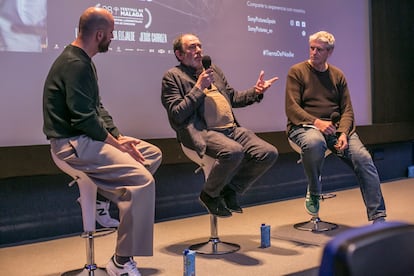As part of the exclusive meetings for the subscribers of El País+, the newspaper organized last Thursday, March 27 in the Sony Pictures Spain projections room, in Madrid, a pre -expensive pass from Nobody’s landto which a colloquium followed with Albert Pintó, director of the film, and one of its protagonists, Karra Elejalde. The meeting was taken by El País Journalist Gregorio Belinchón.
Nobody’s landAlbert’s new film painted, tells the story of three old friends who decided to direct their lives towards contrary causes. At one end is Mateo, The Galiciana civil guard; In the other, Juan, The antxalea Basque drug trafficker; And in between, Benito, The Yeyea Cadiz judicial depositary. All of them live in Barbate, a city transformed by the arrival of international drug trafficking into a violent and chaotic powderie that presents a challenge for them: choose between the friendship that unites them or the different paths that have followed in their lives.
If any of the attendees had prejudices about whether the film would be a thriller Canon full of unjustified action, producer Álvaro Ariza denied it before the transmission when he described it as “an ode to friendship.” Belinchón began the colloquium asking for this aspect he painted and interested in how the script had worked. “When I entered the project there was a first version with a lot of action and I wanted less. I wanted a movie movie, friends,” said the director. In addition, he talked about his fixation because the public could identify with the fears, obsessions, taras and wishes of the characters and thus suffer with them.
Given this, Eleje added: “All those films are very good in which the protagonists impact the bullets in their ears and it seems that they have posed a fly, but I believe the characters if they cry and break down, and in this movie that happens.” The actor aroused the laughter of the room when he confessed that he was so involved in the recording process that came to injure: “The filming was suffered. I was very afraid and told me: ‘Karra, you do not exercise much and you are 64 years old, be careful not to make you an inguinal hernia.” In the end, I got it. “
Belinchón highlighted the good selection of the cast of the film, since, although the plot does not deepen too much in the past of the protagonists, they get the public to empathize with them. According to Elejalde, this is because “friendship is very well sown from the beginning.” “The beautiful thing about cinema is that you can give some information to the public and this is responsible for filling the rest,” he added.
Barbate’s landscape is one of the key elements of the film. The different locations become a narrator in history and transport the spectator to that wild environment. Pintó highlighted the great work of the production team, determining when establishing the recording schedule to get the effect of “golden hour” that stains the entire film and that Elejalde considers “one more protagonist”. However, the director is clear about his favorite location: neither the port, nor the streets of Barbate, nor the Pepa bridge; Painted opts for the marshes. “They are anyone’s earth’s metaphor. It is land and it is water, it is one thing and the other. It is nothing. As soon as I saw them, I was clear that the film had to end there.”
The public also had the opportunity to participate in the colloquium. An assistant asked Pinta if, due to the dose of action demanded by the film, he had been wanting to deepen more in the relationship between the characters, since it is something recurrent in his works. “I always try to put that human dose in my films. I have not stayed with any stuck spine, they have let me make the movie I wanted,” he replied. Once the event ended, some subscribers from El País congratulated the director and the actor for his work in the film.

